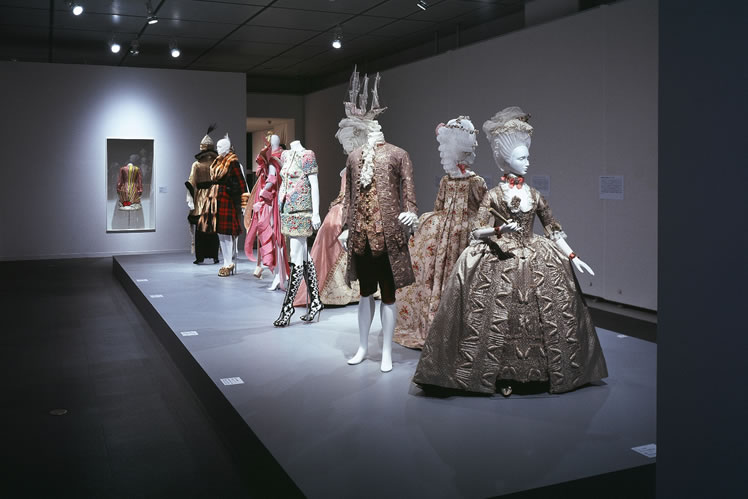Luxury in Fashion Reconsidered
The word “luxury” denotes a richness that derives from excess – an item gorgeous to behold, our special feelings when wearing such an item, our psychological satisfaction at its high refinement. Today, we know lives of material plenty as a result of industrial development. We also face the hard challenges of the global problems our materialistic way of life has created. In these circumstances, our views of luxury, as a manifestation of the richness we desire, are changing dramatically. This exhibition examines our changing times and values from the perspective of luxury, through fashion – a field that sensitively reflects human desire and the trends of society. Featured are some 100 fashion creations dating from the 17th century to current times, carefully selected from multiple perspectives and representing everything from visual luxury to a more personal, intellectual luxury, closer to the spirit of play.
List of Brands or Artists
Balenciaga / Beer / Chanel / Christian Dior / Comme des Garçons / Courréges / Grés /
Issey Miyake / Lanvin / Louis Vuitton / Madeleine Vionnet / Maison Martin Margiela / Paul Poiret / Pierre Cardin / Roy Lichtenstein / Schiaparelli / Thierry Mugler / Viktor & Rolf / Worth / Yves Saint Laurent
Exhibition Outline
Ostentation
Pascal declared, “to be spruce is to show one’s power.” One of the aims of clothing is to flaunt wealth and power. The act of adorning oneself with rare and costly materials arguably represents this eternal human desire, while history has proven that this insatiable passion for adornment has supported and nurtured craftsmen and stimulated the arts and industry. “Ostentation,” the theme of this section, focuses on garments featuring a lavish use of gold and silver thread, and sumptuous dresses representing hundreds of hours of labor and handiwork. Main exhibits: Bodice gifted to Elizabeth I (17th Century), Dress (robe _ la fran_aise)made of silk brocade (18th Century), Reception dress by Maison Worth (c.1900), Party costume for la 1002e nuit by Paul Poiret (1910s), Maison Worth, Chanel (1920s), Elsa Schiaparelli, Christian Dior (1940-50s), Roy Lichtenstein, Pierre Cardin, Courr_ges and Yves Saint Laurent (1960s), Chanel (Karl Lagerfeld), Thierry Mugler (1980-90s), Balenciaga (Nicolas Ghesqui_re), Louis Vuitton (Marc Jacobs) and Viktor& Rolf (2000-) High resolution images of 15 works, presented by PLAYSTATION_3
Less is more
Although people in the past tended to favor clothing that was showy and glamorous, the tendency in the modern age has been to avoid excessive glamour, and instead to prefer simplicity. This tendency has been particularly pronounced with the current and strong demand for comfort and function in design. However, garments that are simple and yet make the wearer appear beautiful require designs that create shape, the appropriate fabrics, and outstanding skills on the part of the creator. This section showcases haute couture, the epitome of simplified design, quality, and exquisite craftsmanship as seen in Chanel’s functional ensembles and Balenciaga’s architectural dresses. Main exhibits: Paul Poiret (1910-1920s), Chanel, Madeleine Vionnet (1920-1930s), Gr_s, Christian Dior, Balenciaga, and Courr_ges (1940-1960s), Yves Saint Laurent, Issey Miyake (1980-90s), Lanvin (Alber Elbaz) (2000-)
Clothes are free-spirited
A Tokyo Culture Creation Project Luxury in fashion Reconsidered: Special Exhibit
Kazuyo Sejima Spatial Design for Comme des Garçons
Luxury is not simply about material and financial wealth. A designer attempts to create a garment that has never been seen before. A wearer encounters that garment, and becomes the receptor of the passion that the designer has directed into that garment. The intense relationship that is generated between the designer and the wearer that surrounds the act of “wearing” is a form of “mental” luxury. This section examines the relationship between clothing and luxury by featuring the designs of Rei Kawakubo who subverted conventional values surrounding “beauty” and “sophistication.” Main exhibits: Comme des Gar_ons (Rei Kawakubo)(1980s-), Photo of exhibit works by Naoya Hatakeyama.
Less is more
Although everyone accepts that rarity in itself adds value, what constitutes rarity for someone may not apply to another. Even objects in everyday life can become “unique” if placed within a completely different context. This is particularly relevant in today’s society, with the growing move away from mass-consumerism. This section features one-off garments by Maison Martin Margiela that represent contemporary concepts of luxury, such as “one-off,” “recyclability,” and “hand-made. ” Main exhibits: Artisanal collection by Maison Martin Margiela (1990s- ).
Supported by: Agency for Cultural Affairs / Ministry of Economy, Trade and Industry / Association for Corporate Support of the Arts
Special support by: Wacoal Corp.
In Cooperation with: Kokonoe Co.,Ltd. (Maison Martin Margiela) / MIKIMOTO / Sony Corporation / Sony Computer Entertainment Inc. / NANASAI CO.,LTD. / Yoshichu Mannequin Co.,Ltd.
© The Kyoto Costume Institute, photo by Naoya Hatakeyama
